ESP MITSUBISHI ECLIPSE CROSS 2020 Owner's Manual (in English)
[x] Cancel search | Manufacturer: MITSUBISHI, Model Year: 2020, Model line: ECLIPSE CROSS, Model: MITSUBISHI ECLIPSE CROSS 2020Pages: 427, PDF Size: 78.05 MB
Page 2 of 427
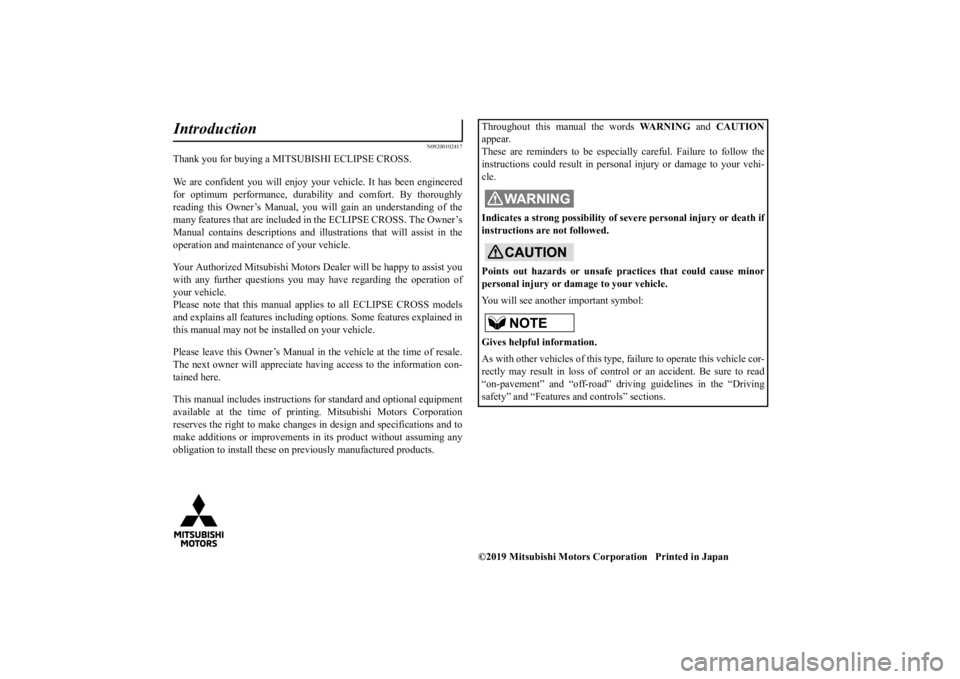
N09200102417
Thank you for buying a MITSUBISHI ECLIPSE CROSS. We are confident you will enjoy your vehicle. It has been engineered for optimum performance, durabi
lity and comfort. By thoroughly
reading this Owner’s Manual, you
will gain an understanding of the
many features that are included in the ECLIPSE CROSS. The Owner’sManual contains descriptions and illus
trations that will assist in the
operation and maintenance of your vehicle. Your Authorized Mitsubishi Motors
Dealer will be happy to assist you
with any further questions you may have regarding the operation ofyour vehicle. Please note that this manual app
lies to all ECLIPSE CROSS models
and explains all features including
options. Some features explained in
this manual may not be installed on your vehicle. Please leave this Owner’s Manual in th
e vehicle at the time of resale.
The next owner will appreciate having access to the information con- tained here. This manual includes instructions fo
r standard and optional equipment
available at the time of printing
. Mitsubishi Motors Corporation
reserves the right to make changes in design and specifications and to make additions or improvements in
its product without assuming any
obligation to install these on previously manufactured products.Introduction
Throughout this manual the words
WARNING
and
CAUTION
appear. These are reminders to be especia
lly careful. Failure to follow the
instructions could result in persona
l injury or damage to your vehi-
cle. Indicates a strong possibility of se
vere personal injury or death if
instructions are not followed. Points out hazards or unsafe pr
actices that could cause minor
personal injury or damage to your vehicle. You will see another important symbol: Gives helpful information. As with other vehicles of this type, failure to operate this vehicle cor- rectly may result in loss of control or an accident. Be sure to read “on-pavement” and “off-road” driving guidelines in the “Drivingsafety” and “Features and controls” sections.©2019 Mitsubishi Motors Corp
oration Printed in Japan
BK0277700US.bo
ok 1 ページ 2019年3月8日 金曜日 午前9時23分
Page 49 of 427
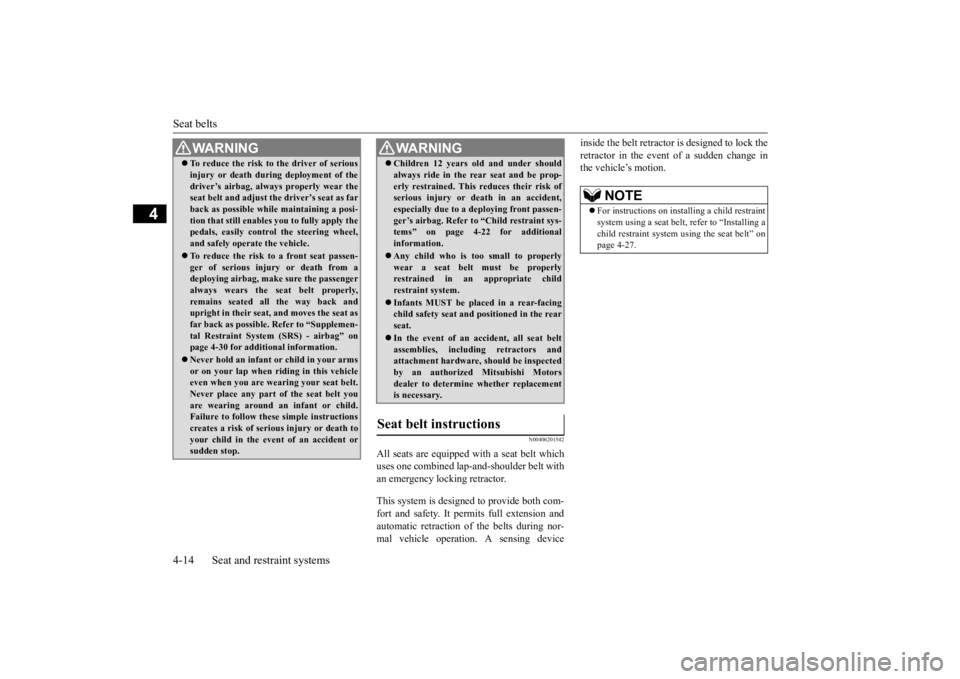
Seat belts 4-14 Seat and restraint systems
4
N00406201542
All seats are equipped with a seat belt which uses one combined lap-and-shoulder belt with an emergency locking retractor. This system is designed to provide both com- fort and safety. It permits full extension and automatic retraction of the belts during nor- mal vehicle operation. A sensing device
inside the belt retractor is designed to lock the retractor in the event of a sudden change in the vehicle’s motion.
To reduce the risk to the driver of serious injury or death during deployment of the driver’s airbag, always properly wear the seat belt and adjust the driver’s seat as far back as possible while maintaining a posi-tion that still enables you to fully apply the pedals, easily control the steering wheel, and safely operate the vehicle. To reduce the risk to a front seat passen- ger of serious injury or death from adeploying airbag, make sure the passenger always wears the seat belt properly, remains seated all the way back andupright in their seat, and moves the seat as far back as possible. Refer to “Supplemen- tal Restraint System (SRS) - airbag” onpage 4-30 for additional information. Never hold an infant or child in your arms or on your lap when riding in this vehicle even when you are wearing your seat belt. Never place any part of the seat belt youare wearing around an infant or child. Failure to follow these simple instructions creates a risk of serious injury or death toyour child in the event of an accident or sudden stop.WA R N I N G
Children 12 years old and under should always ride in the rear seat and be prop- erly restrained. This reduces their risk of serious injury or death in an accident, especially due to a deploying front passen-ger’s airbag. Refer to “Child restraint sys- tems” on page 4-22 for additional information. Any child who is too small to properly wear a seat belt must be properlyrestrained in an appropriate child restraint system. Infants MUST be placed in a rear-facing child safety seat and positioned in the rear seat. In the event of an accident, all seat belt assemblies, including retractors andattachment hardware, should be inspected by an authorized Mitsubishi Motors dealer to determine whether replacementis necessary.
Seat belt instructions
WA R N I N G
NOTE
For instructions on installing a child restraint system using a seat belt, refer to “Installing a child restraint system using the seat belt” on page 4-27.
BK0277700US.bo
ok 14 ページ 2019年3月8日 金曜日 午前9時23分
Page 57 of 427
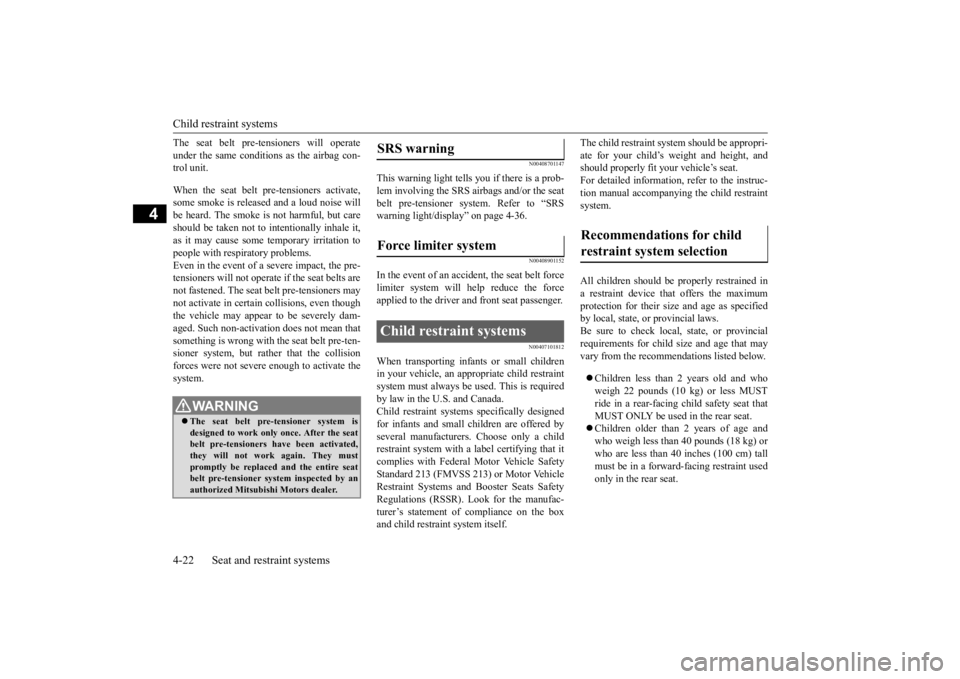
Child restraint systems 4-22 Seat and restraint systems
4
The seat belt pre-tensioners will operate under the same conditions as the airbag con- trol unit. When the seat belt pre-tensioners activate, some smoke is released and a loud noise willbe heard. The smoke is not harmful, but care should be taken not to intentionally inhale it, as it may cause some temporary irritation topeople with respiratory problems. Even in the event of a severe impact, the pre- tensioners will not operate if the seat belts arenot fastened. The seat belt pre-tensioners maynot activate in certain
collisions, even though
the vehicle may appear to be severely dam- aged. Such non-activation does not mean thatsomething is wrong with the seat belt pre-ten- sioner system, but rather that the collision forces were not severe enough to activate thesystem.
N00408701147
This warning light tells you if there is a prob-lem involving the SRS airbags and/or the seatbelt pre-tensioner system. Refer to “SRS warning light/display” on page 4-36.
N00408901152
In the event of an accident, the seat belt force limiter system will help reduce the force applied to the driver and front seat passenger.
N00407101812
When transporting infants or small childrenin your vehicle, an appropriate child restraint system must always be used. This is requiredby law in the U.S. and Canada. Child restraint systems specifically designed for infants and small children are offered byseveral manufacturers. Choose only a child restraint system with a label certifying that it complies with Federal Motor Vehicle SafetyStandard 213 (FMVSS 213) or Motor Vehicle Restraint Systems and Booster Seats Safety Regulations (RSSR). Look for the manufac-turer’s statement of compliance on the box and child restraint system itself.
The child restraint system should be appropri- ate for your child’s weight and height, and should properly fit your vehicle’s seat. For detailed information, refer to the instruc-tion manual accompanying the child restraint system. All children should be properly restrained in a restraint device that offers the maximum protection for their size and age as specifiedby local, state, or provincial laws. Be sure to check local, state, or provincial requirements for child size and age that mayvary from the recommendations listed below. Children less than 2 years old and who weigh 22 pounds (10 kg) or less MUST ride in a rear-facing child safety seat thatMUST ONLY be used in the rear seat. Children older than 2 years of age and who weigh less than 40 pounds (18 kg) orwho are less than 40 inches (100 cm) tall must be in a forward-facing restraint used only in the rear seat.
WA R N I N G The seat belt pre-tensioner system is designed to work only once. After the seat belt pre-tensioners have been activated, they will not work again. They must promptly be replaced and the entire seat belt pre-tensioner system inspected by anauthorized Mitsubishi Motors dealer.
SRS warning Force limiter system Child restraint systems
Recommendations for child restraint system selection
BK0277700US.bo
ok 22 ページ 2019年3月8日 金曜日 午前9時23分
Page 64 of 427
![MITSUBISHI ECLIPSE CROSS 2020 Owners Manual (in English) Child restraint systems
Seat and restraint systems 4-29
4
10. [For front passenger’s seat]
Repeat steps 8 and 9. [For rear seats] Adjust the seatback angle forward untilthe child restraint system MITSUBISHI ECLIPSE CROSS 2020 Owners Manual (in English) Child restraint systems
Seat and restraint systems 4-29
4
10. [For front passenger’s seat]
Repeat steps 8 and 9. [For rear seats] Adjust the seatback angle forward untilthe child restraint system](/img/19/34871/w960_34871-63.png)
Child restraint systems
Seat and restraint systems 4-29
4
10. [For front passenger’s seat]
Repeat steps 8 and 9. [For rear seats] Adjust the seatback angle forward untilthe child restraint system is firmly secured, and then check that the seatback is locked in place. Then push and pull thechild restraint system in all directions to check that it is installed securely. If your child restraint system requires theuse of a tether strap, fasten the tether strapin accordance with the following step 11.
11. Latch the tether strap hook (A) of the
child restraint system to the tether anchorbar (B) and tighten the tether strap so it is securely fastened.
12. Before putting your child in the restraint,
push and pull the restraint in all directionsto be sure it is firmly secure. Do thisbefore each use. If the child restraint sys- tem is not firmly secure, repeat steps 4 through 11.
13. To remove a child restraint system from
the vehicle and deactivate the ALR mode, remove the child from the restraint.Unlatch the buckle. Then remove the belt from the restraint and let the belt fully retract.
14. Reinstall the head restraint.
Refer to “Head restraints” on page 4-9.
N00407601628
Children who have outgrown a child restraint system should be seated in the rear seat andwear the seat belt. If the shoulder belt crosses their face or neck, and/or the lap belt crosses their stomach, a commercially available
booster seat must be used to raise the child so that the shoulder belt crosses their shoulder and the lap belt remains positioned low across their hips. The booster seat should fitthe vehicle seat and have a label certifying compliance with Federal Motor Vehicle Safety Standards or Motor Vehicle RestraintSystems and Booster Seats Safety Regula- tions.
WA R N I N G Child restraint system tether anchors are designed only to withstand loads from cor- rectly fitted child restraint systems. Under no circumstances are they to be used for adult seat belts, harnesses, for attachingother items, or equipment to the vehicle.
Children who have outgrown child restraint systems
WA R N I N G Any child who is too small to properly wear a seat belt must be properly restrained in an appropriate child restraint system, to reduce their risk ofserious injury or death in an accident. A child should never be left unattended in, or unsupervised around, your vehicle. When you leave the vehicle, always take the child out as well. Children can die from he
at stroke if left or
trapped inside the vehicle, especially onhot days. Keep your vehicle locked when not in use. Keep your vehicle keys away from chil- dren.
BK0277700US.bo
ok 29 ページ 2019年3月8日 金曜日 午前9時23分
Page 67 of 427
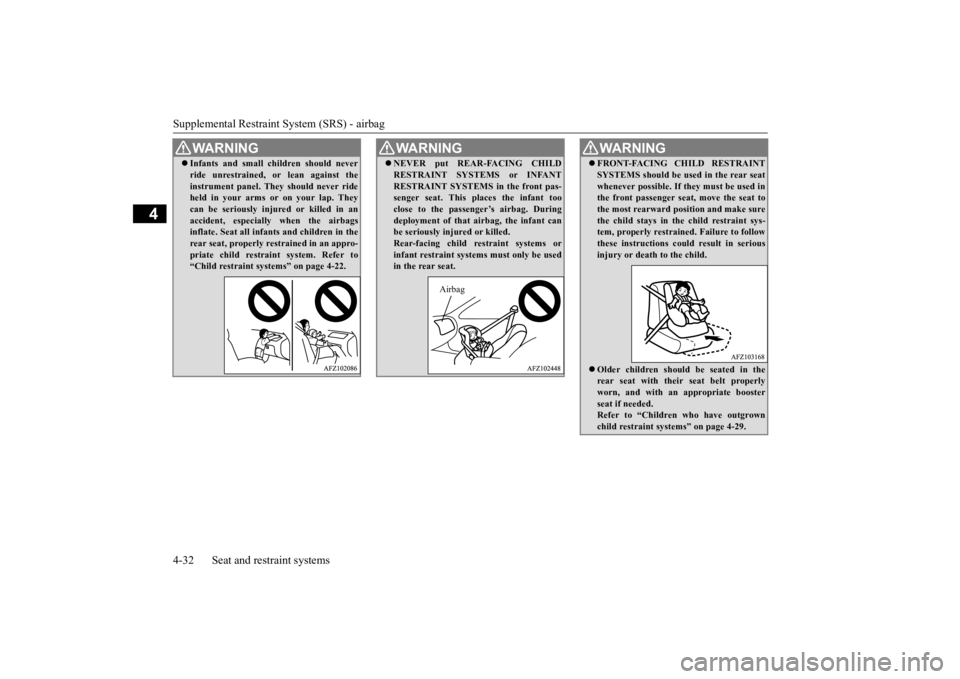
Supplemental Restraint System (SRS) - airbag 4-32 Seat and restraint systems
4
Infants and small children should never ride unrestrained, or lean against the instrument panel. They should never ride held in your arms or on your lap. They can be seriously injured or killed in anaccident, especially when the airbags inflate. Seat all infants and children in the rear seat, properly restrained in an appro-priate child restraint system. Refer to “Child restraint systems” on page 4-22.WA R N I N G
NEVER put REAR-FACING CHILD RESTRAINT SYSTEMS or INFANT RESTRAINT SYSTEMS in the front pas- senger seat. This places the infant too close to the passenger’s airbag. Duringdeployment of that airbag, the infant can be seriously injured or killed. Rear-facing child restraint systems orinfant restraint systems must only be used in the rear seat.WA R N I N G
Airbag
FRONT-FACING CHILD RESTRAINT SYSTEMS should be used in the rear seat whenever possible. If they must be used in the front passenger seat, move the seat to the most rearward position and make surethe child stays in th
e child restraint sys-
tem, properly restrained. Failure to follow these instructions could result in seriousinjury or death to the child. Older children should be seated in the rear seat with their seat belt properlyworn, and with an appropriate booster seat if needed. Refer to “Children who have outgrownchild restraint systems” on page 4-29.WA R N I N G
BK0277700US.bo
ok 32 ページ 2019年3月8日 金曜日 午前9時23分
Page 68 of 427
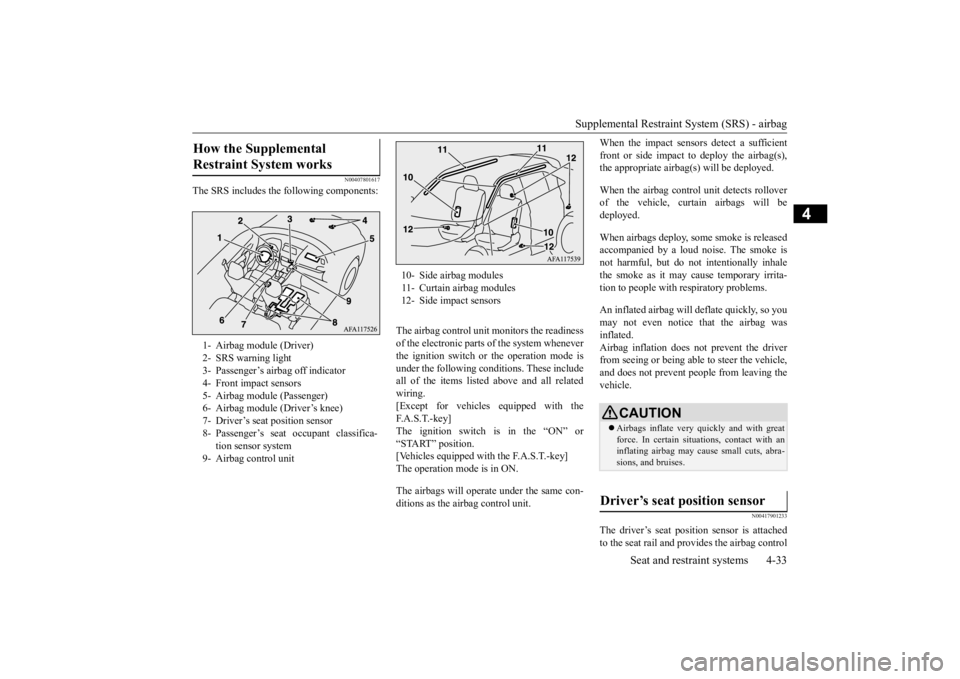
Supplemental Restraint System (SRS) - airbag
Seat and restraint systems 4-33
4
N00407801617
The SRS includes the following components:
The airbag control unit monitors the readiness of the electronic parts of the system whenever the ignition switch or the operation mode isunder the following conditions. These includeall of the items listed above and all related wiring. [Except for vehicles equipped with theF. A . S . T. - k e y ] The ignition switch is in the “ON” or “START” position.[Vehicles equipped with the F.A.S.T.-key] The operation mode is in ON. The airbags will operate under the same con- ditions as the airbag control unit.
When the impact sensors detect a sufficient front or side impact to deploy the airbag(s), the appropriate airbag(s) will be deployed. When the airbag control unit detects rollover of the vehicle, curtain airbags will bedeployed. When airbags deploy, some smoke is released accompanied by a loud noise. The smoke is not harmful, but do not intentionally inhalethe smoke as it may cause temporary irrita-tion to people with respiratory problems. An inflated airbag will deflate quickly, so you may not even notice that the airbag was inflated.Airbag inflation does not prevent the driver from seeing or being able to steer the vehicle, and does not prevent people from leaving thevehicle.
N00417901233
The driver’s seat position sensor is attachedto the seat rail and provides the airbag control
How the Supplemental Restraint System works 1- Airbag module (Driver) 2- SRS warning light 3- Passenger’s airbag off indicator 4- Front impact sensors5- Airbag module (Passenger)6- Airbag module (Driver’s knee) 7- Driver’s seat position sensor 8- Passenger’s seat occupant classifica-
tion sensor system
9- Airbag control unit
10- Side airbag modules 11- Curtain airbag modules 12- Side impact sensors
CAUTION Airbags inflate very quickly and with great force. In certain situations, contact with an inflating airbag may cause small cuts, abra- sions, and bruises.
Driver’s seat position sensor
BK0277700US.bo
ok 33 ページ 2019年3月8日 金曜日 午前9時23分
Page 97 of 427
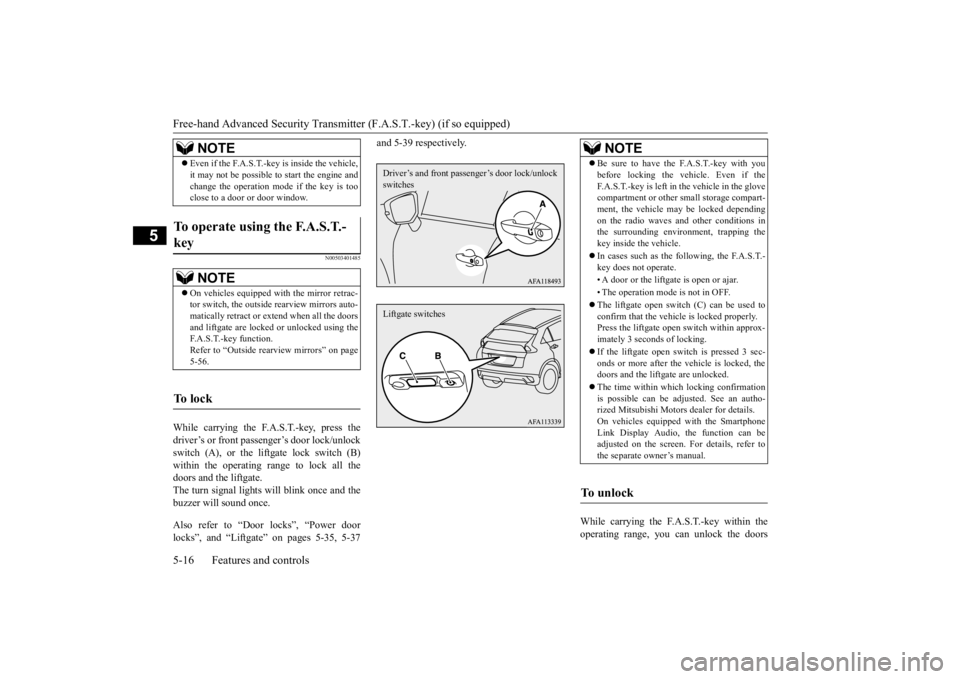
Free-hand Advanced Security Transmitter (F.A.S.T.-key) (if so equipped) 5-16 Features and controls
5
N00503401485
While carrying the F.A.S.T.-key, press the driver’s or front passenger’s door lock/unlock switch (A), or the liftgate lock switch (B) within the operating range to lock all thedoors and the liftgate. The turn signal lights will blink once and the buzzer will sound once. Also refer to “Door locks”, “Power door locks”, and “Liftgate” on pages 5-35, 5-37
and 5-39 respectively.
While carrying the F.A.S.T.-key within the operating range, you can unlock the doors
Even if the F.A.S.T.-key is inside the vehicle, it may not be possible to start the engine and change the operation mode if the key is too close to a door or door window.
To operate using the F.A.S.T.- key
NOTE
On vehicles equipped with the mirror retrac- tor switch, the outside rearview mirrors auto- matically retract or extend when all the doors and liftgate are locked or unlocked using theF.A.S.T.-key function. Refer to “Outside rearview mirrors” on page 5-56.
To l o c k
NOTE
Driver’s and front passen
ger’s door lock/unlock
switchesLiftgate switches
NOTE
Be sure to have the F.A.S.T.-key with you before locking the vehicle. Even if the F.A.S.T.-key is left in the vehicle in the glove compartment or other small storage compart- ment, the vehicle may be locked dependingon the radio waves and other conditions in the surrounding environment, trapping the key inside the vehicle. In cases such as the following, the F.A.S.T.- key does not operate. • A door or the liftgate is open or ajar. • The operation mode is not in OFF. The liftgate open switch (C) can be used to confirm that the vehicle is locked properly. Press the liftgate open switch within approx- imately 3 seconds of locking. If the liftgate open switch is pressed 3 sec- onds or more after the vehicle is locked, thedoors and the liftgate are unlocked. The time within which locking confirmation is possible can be adjusted. See an autho- rized Mitsubishi Motors dealer for details. On vehicles equipped with the SmartphoneLink Display Audio, the function can be adjusted on the screen. For details, refer to the separate owner’s manual.
To u n l o c k
BK0277700US.bo
ok 16 ページ 2019年3月8日 金曜日 午前9時23分
Page 98 of 427
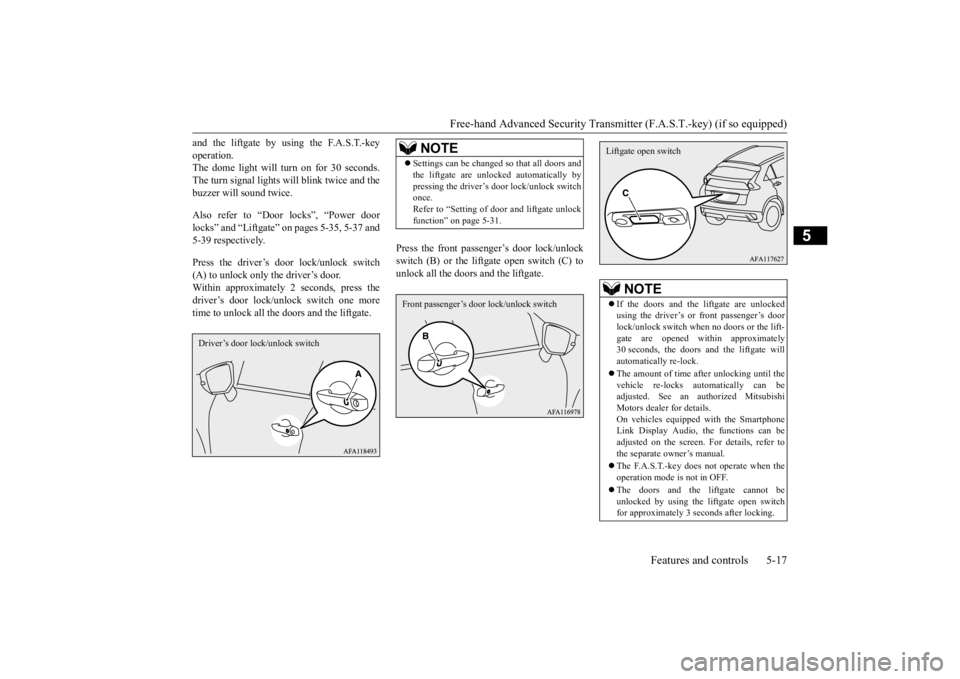
Free-hand Advanced Security Transmit
ter (F.A.S.T.-key) (if so equipped)
Features and controls 5-17
5
and the liftgate by using the F.A.S.T.-key operation. The dome light will turn on for 30 seconds. The turn signal lights will blink twice and thebuzzer will sound twice. Also refer to “Door locks”, “Power door locks” and “Liftgate” on pages 5-35, 5-37 and 5-39 respectively. Press the driver’s door lock/unlock switch (A) to unlock only the driver’s door.Within approximately 2 seconds, press the driver’s door lock/unlock switch one more time to unlock all the doors and the liftgate.
Press the front passenger’s door lock/unlock switch (B) or the liftgate open switch (C) tounlock all the doors and the liftgate.
Driver’s door lock/unlock switch
NOTE
Settings can be changed so that all doors and the liftgate are unlocked automatically by pressing the driver’s door lock/unlock switch once. Refer to “Setting of door and liftgate unlockfunction” on page 5-31.Front passenger’s door
lock/unlock switch
NOTE
If the doors and the liftgate are unlocked using the driver’s or front passenger’s door lock/unlock switch when no doors or the lift- gate are opened within approximately30 seconds, the doors and the liftgate will automatically re-lock. The amount of time after unlocking until the vehicle re-locks automatically can be adjusted. See an authorized MitsubishiMotors dealer for details. On vehicles equipped with the Smartphone Link Display Audio, the functions can beadjusted on the screen. For details, refer to the separate owner’s manual. The F.A.S.T.-key does not operate when the operation mode is not in OFF. The doors and the liftgate cannot be unlocked by using the liftgate open switch for approximately 3 seconds after locking.Liftgate open switch
BK0277700US.bo
ok 17 ページ 2019年3月8日 金曜日 午前9時23分
Page 115 of 427
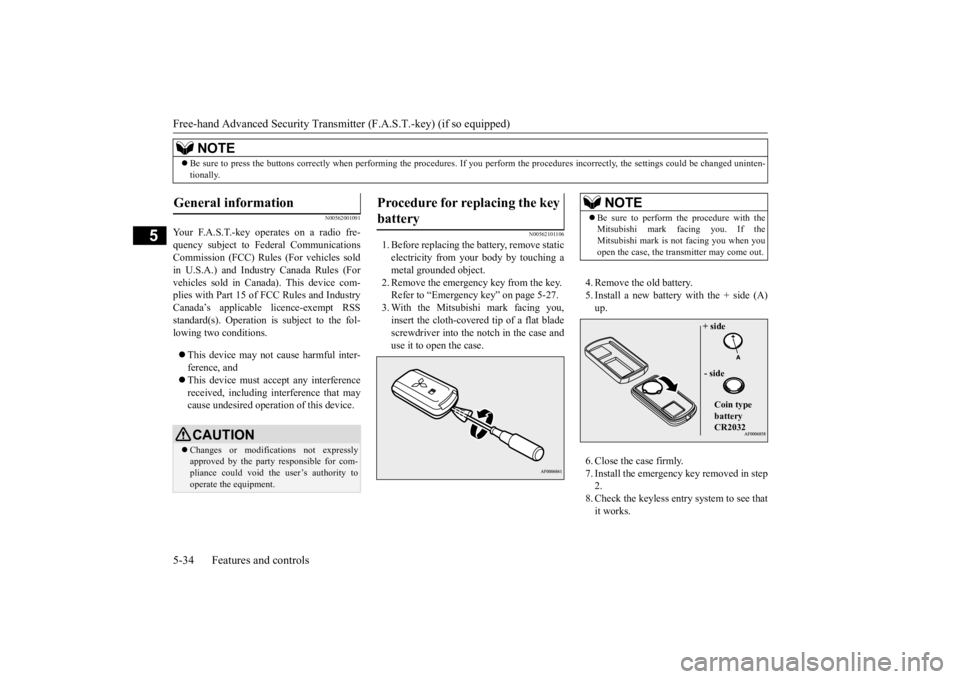
Free-hand Advanced Security Transmitter (F.A.S.T.-key) (if so equipped) 5-34 Features and controls
5
N00562001091
Your F.A.S.T.-key operates on a radio fre- quency subject to Federal Communications Commission (FCC) Rules (For vehicles soldin U.S.A.) and Industry Canada Rules (Forvehicles sold in Canada). This device com- plies with Part 15 of FCC Rules and Industry Canada’s applicable licence-exempt RSSstandard(s). Operation is subject to the fol- lowing two conditions. This device may not cause harmful inter- ference, and This device must accept any interference received, including interference that may cause undesired operation of this device.
N00562101106
1. Before replacing the battery, remove staticelectricity from your body by touching ametal grounded object.2. Remove the emergency key from the key. Refer to “Emergency key” on page 5-27. 3. With the Mitsubishi mark facing you,insert the cloth-covered tip of a flat blade screwdriver into the notch in the case and use it to open the case.
4. Remove the old battery. 5. Install a new battery with the + side (A) up. 6. Close the case firmly. 7. Install the emergency key removed in step 2. 8. Check the keyless entry system to see thatit works.
NOTE
Be sure to press the buttons correctly when performing the pro
cedures. If you perform the proce
dures incorrectly, the settings
could be changed uninten-
tionally.
General information
CAUTION Changes or modifications not expressly approved by the party responsible for com-pliance could void the user’s authority to operate the equipment.
Procedure for replacing the key battery
NOTE
Be sure to perform the procedure with the Mitsubishi mark facing you. If the Mitsubishi mark is not facing you when you open the case, the transmitter may come out.
+ side - side Coin type battery CR2032
BK0277700US.bo
ok 34 ページ 2019年3月8日 金曜日 午前9時23分
Page 116 of 427
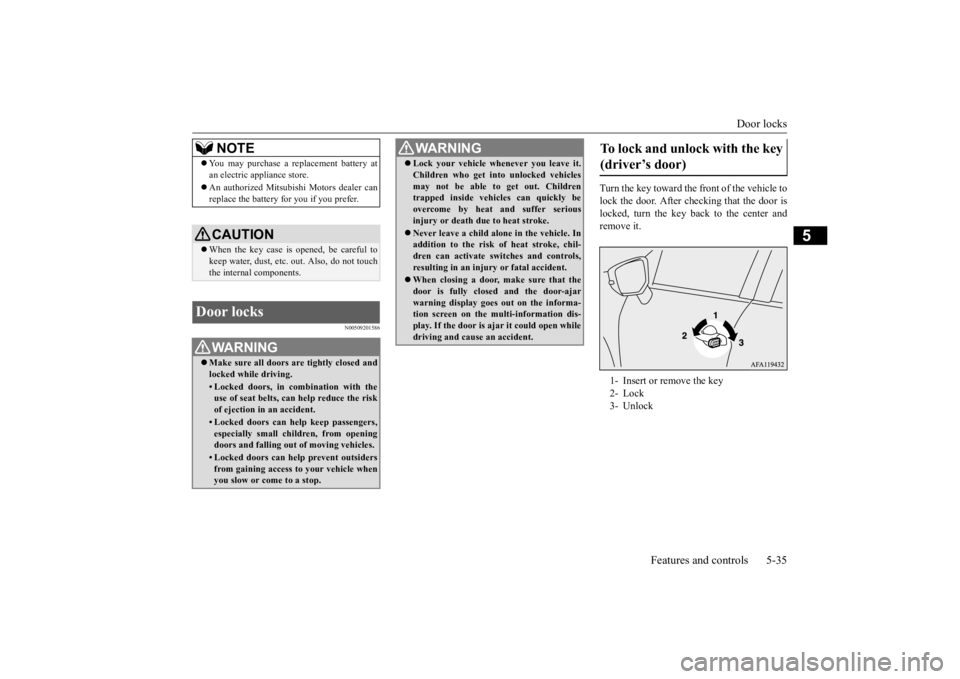
Door locks
Features and controls 5-35
5
N00509201586
Turn the key toward the front of the vehicle to lock the door. After ch
ecking that the door is
locked, turn the key back to the center and remove it.
NOTE
You may purchase a replacement battery at an electric appliance store. An authorized Mitsubishi Motors dealer can replace the battery for you if you prefer.CAUTION When the key case is opened, be careful to keep water, dust, etc.
out. Also, do not touch
the internal components.
Door locks
WA R N I N G Make sure all doors are tightly closed and locked while driving.• Locked doors, in combination with theuse of seat belts, can help reduce the risk of ejection in an accident.• Locked doors can help keep passengers,especially small children, from opening doors and falling out of moving vehicles.• Locked doors can help prevent outsidersfrom gaining access to your vehicle when you slow or come to a stop.
Lock your vehicle whenever you leave it. Children who get into unlocked vehicles may not be able to get out. Children trapped inside vehicles can quickly be overcome by heat and suffer seriousinjury or death due to heat stroke. Never leave a child alone in the vehicle. In addition to the risk of heat stroke, chil- dren can activate switches and controls, resulting in an injury or fatal accident. When closing a door, make sure that the door is fully closed and the door-ajarwarning display goes out on the informa- tion screen on the multi-information dis- play. If the door is ajar it could open whiledriving and cause an accident.WA R N I N G
To lock and unlock with the key (driver’s door) 1- Insert or remove the key 2- Lock 3- Unlock
BK0277700US.bo
ok 35 ページ 2019年3月8日 金曜日 午前9時23分